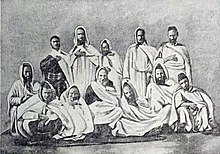Toshavim
- View a machine-translated version of the French article.
- Machine translation, like DeepL or Google Translate, is a useful starting point for translations, but translators must revise errors as necessary and confirm that the translation is accurate, rather than simply copy-pasting machine-translated text into the English Wikipedia.
- Consider adding a topic to this template: there are already 6,211 articles in the main category, and specifying
|topic=will aid in categorization. - Do not translate text that appears unreliable or low-quality. If possible, verify the text with references provided in the foreign-language article.
- You must provide copyright attribution in the edit summary accompanying your translation by providing an interlanguage link to the source of your translation. A model attribution edit summary is
Content in this edit is translated from the existing French Wikipedia article at [[:fr:Tochavim]]; see its history for attribution. - You may also add the template
{{Translated|fr|Tochavim}}to the talk page. - For more guidance, see Wikipedia:Translation.

Toshavim (Hebrew: תושבים, "residents") is a generic reference to non-Sephardic Jews who inhabited lands in which the Jews expelled from Spain in 15th century settled ("Megorashim", "expellees").[1] The Jews in the area of North Africa known as Maghreb are also referred to as Maghrebim (Maghrebi Jews). In particular, the term "Toshavim" was applied to the Jews of Morocco. Both groups are considered indigenous to the area despite their migration and diaspora origins.
During the middle ages migration between the Iberian Peninsula and North Africa was common due to local political and economic conditions and depending on the ruling kingdom and treatment of Jews.[1] Jews from Spain often fled to Morocco as early as the seventh century and during the twelfth century, Jews in both countries fled, crossing back and forth between the two lands.[1]
Toshavim had their own minhagim (Judaic traditions) and they spoke Judeo-Arabic or Judeo-Berber dialects.
The new arrivals did not always deal well with the local Jews. For example, in Algiers they called the local Jews derisively "turban-wearers" and vice versa, the Spanish Jews were called "beret-wearers".[2][3]
Despite the fact that Toshavim were apparently overwhelmed and absorbed by Sephardic immigrants, the differences in many areas of communal lives of Toshavim and Megorashim persisted for a very long time: separate negidim, separate synagogues, separate teachers, separate cemeteries, etc.[4] For example, in Fez, Morocco, the common minhag for (most of) the two communities was accepted only in 18th century.[5]
See also
- Berber Jews
- Musta'arabi Jews
- Terefah controversy [he], a severe halakhic controversy about a specific type of terefah, among the Fez Jewry between Toshavim and Megorashim
- Al Fassiyine Synagogue
References

- ^ a b c "Toshavim", Brill online
- ^ Richard Ayoun, "A l’arrivée des Juifs espagnols en Algérie : mutation de la communauté"
- ^ Richard Ayoun, "Le Judaïsme Séfarade après l'expulsion d'Espagne de 1492, est-il un monde éclaté", Histoire, économie & société, 1991, vol 10, no.2 pp. 143-158, doi:10.3406/hes.1991.1571
- ^ Jane S. Gerber, "THE DEMOGRAPHY OF THE JEWISH COMMUNITY OF FEZ AFTER 1492", Proceedings of the World Congress of Jewish Studies, 1973, pp. 31-44 JSTOR 23529108
- ^ Gilson Miller, Susan; Petruccioli, Attilio; Bertagnin, Mauro (2001). "Inscribing Minority Space in the Islamic City: The Jewish Quarter of Fez (1438-1912)". Journal of the Society of Architectural Historians. 60 (3): 310–327. doi:10.2307/991758. JSTOR 991758.










